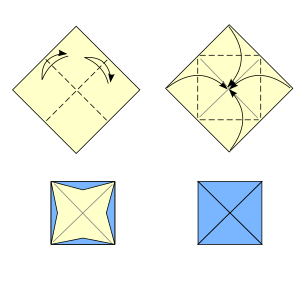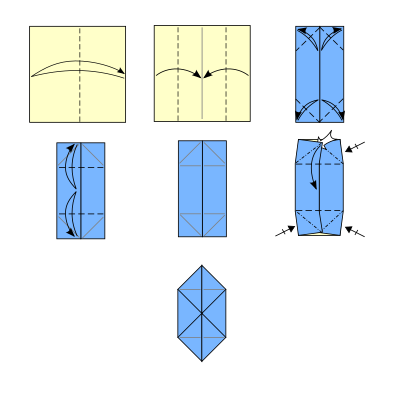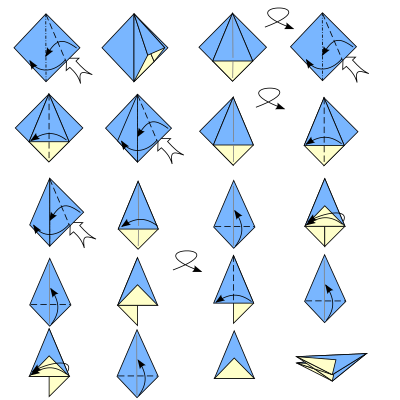How to Make a Origami Frog Base
In origami, a model base is the structural skeleton of an origami model in its simplest form. The usage of a base has many benefits; the folding sequence will be easier to remember and create diagrams for, and further models can be developed from the same base, or from slight modifications thereof. However, the use of a base does, to a certain extent, limit what can be done with the model.
Traditional origami models were often developed from similar patterns. While some of them are rarely used, there are six that are used quite frequently: the waterbomb base, preliminary fold, kite base, fish base, bird base and frog base. Most recently published books only assume the knowledge of these bases; however, some authors still use unconventional bases.
These bases are referred to as the classic bases, and were used as the primary design technique until the 1960s. They all share the same symmetry, and certain structural properties. In the 1960s, paperfolders started trying to find new bases to create more complex models. One of the new techniques they developed was to fold the corners into the center (a blintz base), fold the base, and then unwrap the extra layers of paper. This technique allowed folders to multiply the number of points on the base, and is referred to as "blintzing" the base.
The windmill base, helmet base, umbrella base and pig base are found in traditional models, but not used or accepted as widely.
Models are typically classified by the number of simultaneous folds to realize. The more the number of folds is high, the more the techniques involved in the construction is complex.
One fold [edit | edit source]
- The book fold is a valley fold that folds the paper by the middle and entirely covers the side up.

- The cupboard fold is two valley folds that push the edges of the paper to the middle.

- The pleat fold is several evenly-spaced parallel mountain and valley folds. It is also called an "accordion fold."

- The radial pleat fold is an angled pleat fold, usually with a focus point on an edge or corner.
- The kite base is merely two valley folds that bring two adjacent edges of the square together to lie on the square's diagonal.

- The helmet base consists of a diagonal valley fold that bisects two corners of the square and two perpendicular valley folds that push two corners of the triangle to the third one.

- The blintz fold is made by folding the corners of a square into the center. This can be achieved with higher accuracy by folding and unfolding two reference creases through the center.

Origamis that are done by creating only one fold at a time are called pureland origami. Because of these restrictions, proponents of the theory have devised alternate methods of folding more complicated steps that have very similar results.
Two folds [edit | edit source]
- The preliminary fold or square base consists of a diagonal mountain fold that bisects two corners of the square and two perpendicular valley folds that bisect the edges of the square. The paper is then collapsed to form a square shape with four isosceles-right triangular flaps.

Preliminary fold or Square Base
- The waterbomb base consists of two perpendicular valley folds down the diagonals of the square and a mountain fold down the center of the square. This crease pattern is then compressed to form the waterbomb base, which is an isosceles-right triangle with four isosceles-right triangular flaps. The waterbomb base is an inside-out square base.

- The pig base consists of a cupboard fold with all the paper corner squash folded to the center of the paper. All the paper edge is along the middle line.

- The umbrella base consists of a square base with all the flaps squash folded and the isosceles-right triangular flaps valley folded on the big isosceles triangle.

- The windmill base consists of four square bases on a single square.

Three folds [edit | edit source]
- The fish base consists of two radial folds against a diagonal reference crease on each of two opposite corners. The flaps that result on the other two corners are carefully folded downwards in the same direction. In other words, it consists of two side-by-side rabbit ears.

- The bird base, or crane base, consists of a square base with both the front and the back sides petal folded upward.

Bird base constructed on a preliminary fold
- The frog base starts with a waterbomb base or square base. All four flaps are squash-folded (the result is the same in either case), and then the corners are petal folded upward.

Frog base constructed on a preliminary fold
- Most of the creases in a stretched bird base are present in the regular bird base. When forming this bird base, make sure to crease the triangle at the center corner through all layers. (If you unfold completely, you will see a small square at the center of the paper.) After forming the bird base, either partially unfold the paper, and/or "stretch" two opposite corners of the bird base. These two corners, their associated flaps, and the central square will all lie flat. The other two flaps will form a pyramid. Rabbit ear each flap that is in the pyramid, so that the model lies flat. All of the raw edges will lie along the centerline of the model. The stretched bird base is used in Lang's Bald Eagle, Greenberg's Eeyore, and some other high-intermediate and complex models.
If a square is blintz folded, then a kite/fish/bird/frog base is folded, and the blintzed edges teased out and collapsed n a certain fashion, this is called a blintzed kite/fish/bird/frog/base, which doubles the complexity and adds more points and edges to the original kite/fish/bird/frog base, for a more complex model that requires more points. It's possible to double blintz for a double blintzed kite/fish/bird/frog base if needed. Theoretically an infinite number of blintzes could be performed to yield an infinitely complex multipointed base, but paper thickness restricts this to generally two blintzes.
How to Make a Origami Frog Base
Source: https://en.wikibooks.org/wiki/Origami/Techniques/Model_bases
0 Response to "How to Make a Origami Frog Base"
Post a Comment